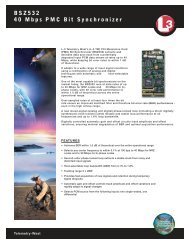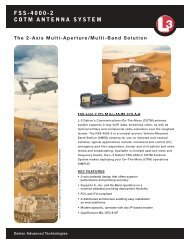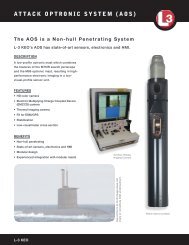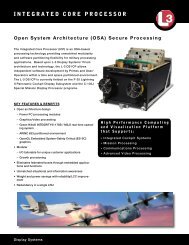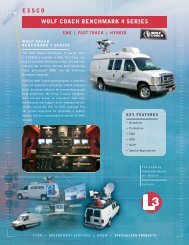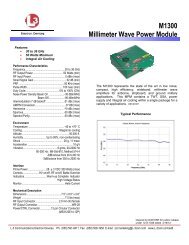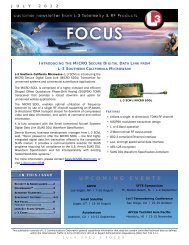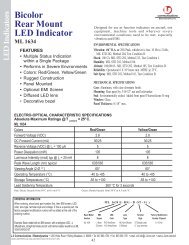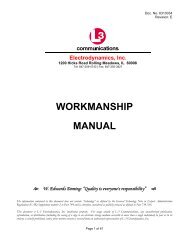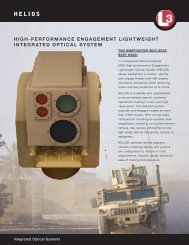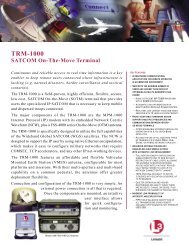Copyright © 2009 IEEE. Reprinted from Microwave Magazine - L-3 ...
Copyright © 2009 IEEE. Reprinted from Microwave Magazine - L-3 ...
Copyright © 2009 IEEE. Reprinted from Microwave Magazine - L-3 ...
You also want an ePaper? Increase the reach of your titles
YUMPU automatically turns print PDFs into web optimized ePapers that Google loves.
grip on power is being challenged by SSPAs. For example,at C-band, commercially available modular SSPAsare capable of producing 1.5 kW of output power, and3.0 kW by phase-combining two systems [13]. However,these SSPAs are still relatively inefficient, withefficiency at less than 20%. Compared to a linearizedTWTA (LTWTA) producing similar RF power,the above SSPA would cost US$14,000 more in annualelectricity cost [14].Collector depression is a common technique forimproving the efficiency of TWTs [1]. Using a depressedcollector, one can convert some of the kinetic energy inthe spent electron beam (i.e., after its interaction withthe slow-wave circuit) into the potential energy of thepower supplies and, therefore, increase the overall efficiencyof the device [1, ch. 14]. Additional improvementcan be achieved by employing a multistage depressedcollector (MSDC) that can better match the energydistribution of the spent beam. The total efficiency ofstate-of-the-art space TWTs with a MSDC is over 70%[15] with typical TWTA efficiency between 50–60%. Thetypical SSPA’s efficiency is about 25–30% [16].The linearity of a power amplifier is always of greatimportance. For communication applications, theTWTA has long been considered as a device with poorlinearity as compared to the SSPA. The general belief isthat a TWTA must be backed off 3–4 dB <strong>from</strong> saturationto achieve the same level of linearity as an SSPA. This isan incomplete statement. It was pointed out in [16] thatthe power consumed by a TWTA is usually less thanthat of an SSPA with only half of the rated RF power. Asa result, for two amplifiers with the same total powerconsumption, a TWTA generally has more available linearpower than an SSPA for most of the frequency band.The two amplifiers have the same linearity performancefor lower-power and lower-frequency amplifiers only.Furthermore, the linearity of a TWTA can be improvedmuch more by use of linearization than that of an SSPA.As a result, more of the TWTA’s RF power that is lostdue to output backoff is available as linear power.Predistortion linearization is a simple and effectivetechnique for improving the performance of bothSSPAs and TWTAs [17]. Its effectiveness on TWTAs ismore significant because of the slow approach to saturationand the higher nonlinearity of the TWTA. It hasbeen shown that by applying fifth-order linearization,it is possible to achieve less than 1 dB overall gain compressionat saturation so that the combined transfercurve approaches that of an ideal linear limiter [18].Consequently, the need for backoff <strong>from</strong> saturation canbe greatly reduced to take advantage of the higher efficiencynear saturation.The effect of reduced efficiency by operating significantlybelow saturation to obtain linearity can bemitigated by reoptimizing the helix circuit for reducedgain compression and phase shift. It can also be mitigatedby reoptimizing the MSDC (both the collectorOnly vacuum electronic devices meetmany of the demanding requirementsfor reliable performance.Power (W)3,0002,0001,0000C X Ku DBSFrequency Banddesign and depressed voltages) to better match thespent beam distribution at large backoff operation.This will improve the collector efficiency and, therefore,the total efficiency. L-band and S-band TWTs at200–300 W output with 25–40% efficiency and eighttonecarrier-to-intermodulation ratio levels of 270 dBchave been produced with this technique. This performanceis a significant improvement over solidstatesystems having the same fidelity and twice theefficiency of SSPA [19].Recently, a new unexplored regime of TWT operation,based on the transverse interaction betweenan electron beam and a circularly polarized circuitwas investigated [20]. It was predicted that aC-band transverse TWT could be more efficient andmore linear—12 dB smaller value for the carrier-tointermodulationratio—than a conventional longitudinalTWT with a comparable saturated power. SuchTWTAs, if implemented, could meet the demandingrequirement for high-data-rate communication.The last decade has also seen a leap in the performanceof helix TWTs. These devices have criticalapplications in high-data-rate communications,high-resolution radar, and broadband electronic warfare.For example, in [21], a record helix TWT performancehas recently been reported at C- and X-band,with 25 kW and 8 kW peak power for radar applications.Compact (around 3.5 lb) helix TWTs at Ka-band(30 GHz) with 500 W continuous wave (CW) power,and 55% efficiency and at Q-band (44 GHz), with 230W CW power and 43% efficiency [22] have been demonstratedfor communication applications. A majorcontributing factor for the millimeter-wave TWTKaTWTASSPAKPAFigure 5. Typical power of commercial satellitecommunication high-power amplifiers including travelingwavetube amplifier (TWTA), klystron power amplifier(KPA) and solid-state power amplifier (SSPA).QDecember <strong>2009</strong> 41Authorized licensed use limited to: US Army Research Laboratory. Downloaded on December 2, <strong>2009</strong> at 13:24 <strong>from</strong> <strong>IEEE</strong> Xplore. Restrictions apply.



